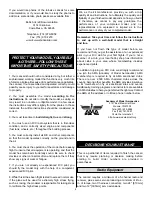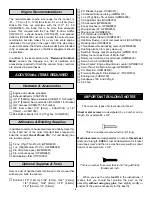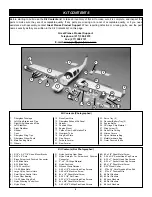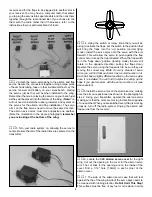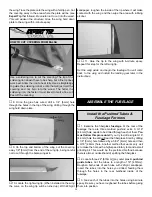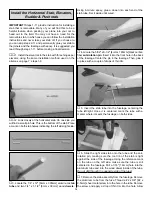
The recommended engine size range for the Lancair is
.61 – .75 cu in [10 – 12cc] two-stroke, .91 cu in [15cc] four-
stroke. We flew our prototype with the O.S.
®
.61 FX
(OSMG0561). We found this to be more than adequate
power. This coupled with the Top Flite
®
In-Cowl muffler
(TOPQ7917), exhaust header (TOPQ7920), and exhaust
deflector (HCAP2180) not only provided the correct power
combination but also makes for a very nice scale engine
installation. If an engine in the upper end of the size range
is used, remember that this is a scale model that is intended
to fly at scale-like speeds, so throttle management should
be practiced.
In addition to the items listed in the
“Decisions You Must
Make” section, the following is a list of hardware and
accessories required to finish the Lancair. Order numbers
are provided in parentheses.
❏
Engine and suitable propellers
❏
Exhaust deflector (HCAP2180)
❏
(2) 12" [300mm] Servo extension (HCAM2711 for Futaba
®
)
❏
(2) 24" [610mm] Servo extension (HCAM2721 for Futaba)
❏
(2) Y-harness (HCAM2751 for Futaba)
❏
R/C foam rubber (1/4" [6mm] – HCAQ1000, or 1/2"
[13mm] – HCAQ1050)
❏
#64 Rubber bands (1/4 lb [113g] box, HCAQ2020)
In addition to common household tools and hobby tools, this
is the “short list” of the most important items required to
build the Lancair.
Great Planes Pro
™
CA and Epoxy glue
are recommended.
❏
1/2 oz. [15g] Thin Pro CA (GPMR6001)
❏
1 oz. [30g] Medium Pro CA+ (GPMR6008)
❏
Pro 30-minute epoxy (GPMR6047)
❏
Pro 6-minute epoxy (GPMR6045)
❏
Microballoon filler (TOPR1090)
Here is a list of optional tools mentioned in the manual that
will help you build the Lancair.
❏
Drill bits: 1/16" [1.6mm], 5/64" [2mm], 3/32" [2.4mm],
1/8" [3.2mm], 5/32" [4mm], 3/16" [4.8mm],
7/32" [5.6mm], 1/4" [6.4mm]
❏
#11 Blades (5-pack, HCAR0211)
❏
3 Standard silicone tubing (GPMQ4131)
❏
2 oz. [57g] Spray CA activator (GPMR6035)
❏
CA applicator tips (HCAR3780)
❏
CA debonder (GPMR6039)
❏
Epoxy brushes (6, GPMR8060)
❏
Mixing sticks (50, GPMR8055)
❏
Mixing cups (GPMR8056)
❏
36" metal ruler (HCAR0475)
❏
Robart Super Stand II (ROBP1402)
❏
Hobbico
®
Duster
™
can of compressed air (HCAR5500)
❏
Masking tape (TOPR8018)
❏
Threadlocker thread locking cement (GPMR6060)
❏
Rubbing alcohol (for epoxy clean up)
❏
Switch & Charge Jack Mounting Set (GPMM1000)
❏
Rotary tool such as Dremel
®
Moto-Tool
®
❏
Rotary tool reinforced cut-off wheel (GPMR8200)
❏
Servo horn drill (HCAR0698)
❏
Dead Center
™
Engine Mount Hole Locator (GPMR8130)
❏
Accu-Throw
™
Deflection Gauge (GPMR2405)
❏
CG Machine
™
(GPMR2400)
❏
Precision Magnetic Prop Balancer
™
(TOPQ5700)
❏
Sealing Iron (TOPR2100)
❏
Sandpaper–100, and 220-grit
❏
6-32 Tap
•
There are two types of screws used in this kit:
Sheet metal screws are designated by a number and a
length. For example #6 x 3/4".
This is a number six screw that is 3/4" long.
Machine screws are designated by a number, threads per
inch, and a length. SHCS is just an abbreviation for “socket
head cap screw” and that is a machine screw with a socket
head. For example 4-40 x 3/4".
This is a number four screw that is 3/4" long with forty
threads per inch.
•
When you see the term
test fit in the instructions, it
means that you should first position the part on the
assembly without using any glue, then slightly modify or
custom fit the part as necessary for the best fit.
IMPORTANT BUILDING NOTES
Optional Supplies & Tools
Adhesives & Building Supplies
Hardware & Accessories
ADDITIONAL ITEMS REQUIRED
Engine Recommendations
4
Summary of Contents for Lancair ES
Page 40: ......



